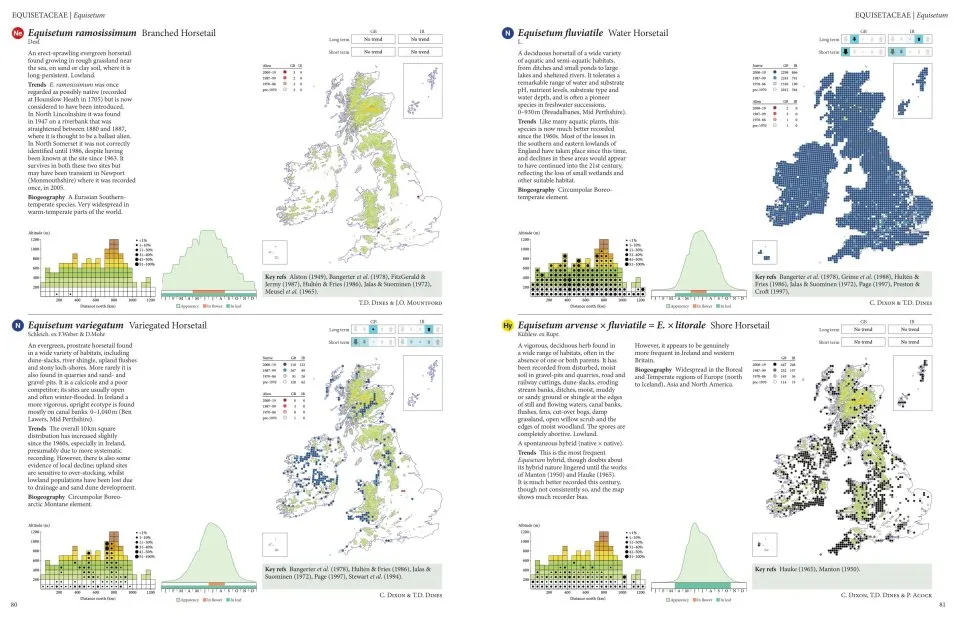Let us start with the weight. The first Atlas of the British Flora, published in 1962, weighed about 2kg. The New Atlas of 2002 was twice that. But Plant Atlas 2020, which comes in two fat volumes inside a slip-case, tips the scales at 10kg. This is not a book to read in bed.
There are reasons for this exponential growth. The first atlas reproduced maps, four per page, but no text. The second added a summary text for each species. The new one adds diagrams, on altitude limits, times in flower and in bud, and ‘apparency’, an unfamiliar graphic which combines phenology and ‘detectability’.
It also includes more plants: many more. The 3,445 species covered include all natives and established aliens, all the more widespread hybrids, and also ‘frequently recurrent casuals’. It includes significant subspecies and, for the first time, charophytes, algae which are recordable and are treated as honorary vascular plants. Introduced species now outnumber native ones. The scientific names used are those of the most recent edition of Stace’s New Flora of the British Isles (2019), replete with unfamiliar coinages.
View this book on the NHBS website
The record-base has also increased enormously. There are some 26 million individual records in this atlas, all made by volunteers over a staggering 178,000 recording days between 2000 and 2019. For the first time, records were entered into the database electronically via a computer package called MapMate. Significantly, three of the five authors are data-analysts and web-developers. For the first time we have a complete coverage, particularly in Ireland, revealing that our commonest plants, including Sorrel, Yarrow and Daisy, are found in every single hectad in Britain and Ireland.
The date-class was also amplified. Native plants are recorded in blue; introduced ones in red; and those impossible to separate thus are in black. Records from the past 20 years are mapped in the darkest colour, and there are successively paler colours for 1987–1999; 1970–86; and pre 1970. Each plant has a summary text divided between a description and habitat range; population trends; and ‘biogeography’, i.e. world range.
There is a lengthy introduction to all this in Volume 1, including a discussion of recently discovered native ‘taxa’, short- and long-term trends in the flora, plus a lot of technical stuff for those familiar with data analysis. The atlas is well designed with a good dark font on white paper, although it is made to be pored over rather than read. Non-botanists might wonder why plants are always referred to by their scientific names, but this is a formal publication, very conscious of its peer-group, and of its importance as a database for nature conservation and even government.
To suggest that Plant Atlas 2020 is a formidable achievement of British and Irish field botany rather undervalues it. It has left me breathless. The first thing one notices is the rising tide of aliens. The atlas includes, for instance, 23 species of conifer, 21 cotoneasters, 12 honeysuckles, five Michaelmas daisies and nine ‘taxa’ of Amaranthus. Of critical species, hawkweeds and dandelions are not individually mapped, since recent BSBI Monographs cover them (or, for hawkweeds, some of them), but the atlas does include all the many forms of Sorbus and Limonium, and no fewer than seven varieties of Red Fescue Festuca rubra.
For some species, the atlas attempts to distinguish between native and introduced ranges, so that, for example, the blue dots of Welsh Poppy, Jacob’s-ladder and Large-leaved Lime are isolated in a sea of red. The native ranges of Beech, Hornbeam, Black Poplar, Small-leaved Lime and Box are not distinguished from planted, which looks like a missed opportunity, though one appreciates the problem. The distinction lies in the eye of the recorder, and is becoming increasingly blurred, not least because of conservation planting and the sowing of ‘wild flower’ seed mixtures.
Those who follow the twists and turns of ‘native status’ will not be surprised that many plants once considered native are now seen as aliens and mapped in red, not blue, even when they have been present for thousands of years. Personally, knowing the psychology of civil servants, I would have mapped archaeophytes in blue for their own protection. Just two species seem to have made the opposite journey: French Oat-grass Gaudinia fragilis and Hairy-fruited Cornsalad Valerianella eriocarpa are now probably native.
What does the atlas reveal? To go into any detail would require a full article, but very broadly our native plants are declining (53% of them have decreased in range), while aliens are doing very well with an overall 58% increase. The greatest declines are with plants of infertile ground, habitat specialists, and those associated with cultivated land. There is a strong correlation between increased fertility and decreased plant diversity, as demonstrated on any road verge or river bank near you. Some southern species have increased their range northwards, and some northern ones are in retreat. What can be done about it? Not much, I suspect.
I noticed one tiny typo. On page 1,284, Cotton Deer-grass died out in 1808, not 1888. I was puzzled at the omission of two well-known rarities, Martin’s Ramping-fumitory Fumaria reuteri and Smooth Cord-grass Spartina alterniflora; perhaps they are in the online version.


